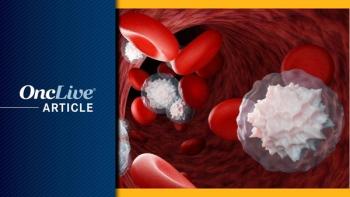
Garon Sheds Light on CNS Activity With Capmatinib in MET Exon 14+ NSCLC
Edward B. Garon, MD, MS, discusses the importance of the GEOMETRY mono-1 study in patients with advanced NSCLC who harbor MET exon 14 skipping mutations.
Edward B. Garon, MD
Capmatinib (INC280) demonstrated high objective response rates (ORRs) that were durable in patients with advanced non—small cell lung cancer (NSCLC) who harbor MET exon 14 skipping mutations, according to findings from cohorts 4 and 5b of the GEOMETRY mono-1 study (NCT0241413) presented during the 2020 AACR Virtual Annual Meeting I.
“The GEOMETRY mono-1 study is in many respects confirmation of a biomarker identifiable group of patients that benefit from MET inhibition. Capmatinib is an effective agent with a tolerable safety profile that is very appropriate for patients [with MET exon 14 skipping mutations],” said lead study author Edward B. Garon, MD, MS.
The trial grouped patients into 7 cohorts; those in cohort 4 had received at least 1 prior line of therapy, and those in cohort 5b were treatment naïve. The ORR, as per a blinded independent review committee, was 40.6% in cohort 4 and 67.9% in cohort 5b, meeting the primary end point of the trial. The median duration of response (DOR) was 9.72 months and 11.14 months in cohorts 4 and 5b, respectively.
Notably, responses were also observed in patients with central nervous symptom (CNS) involvement (n = 13), who were eligible for enrollment if they had stable or asymptomatic brain metastases, despite not having received local therapy. In this population, 4 patients had complete resolution of all brain lesions and the other 3 responding patients had complete resolution in 3 lesions with stabilization in 4; complete resolution in 2 lesions with stabilization in 1; and compete resolution in 1 lesion with stabilization in 3.
In terms of toxicity, 35.6% of patients experienced grade 3/4 adverse events (AEs), the most common of which was peripheral edema (all-grade, 41.6%; grade 3/4, 7.5%). Overall, 21.9% of patients received a dose reduction and 11.1% discontinued therapy due to treatment-related AEs.
In an interview with OncLive, Garon, associate professor of medicine, David Geffen School of Medicine, University of California, Los Angeles, discussed the importance of the GEOMETRY mono-1 study and the findings from cohorts 4 and 5b in patients with advanced NSCLC who harbor MET exon 14 skipping mutations.
OncLive: Could you discuss the unmet need for patients with MET exon 14 skipping mutations?
Garon: Patients with MET exon 14 skipping mutations are a recently identified group of patients who appear to have a somewhat worse prognosis overall. Certainly, compared with some of the driver mutation—positive patients [with] conventional therapies, such as chemotherapy. There are also some emerging data that indicate that perhaps these patients do not do particularly well with immunotherapy either.
What was the design of the trial, and what were some of the key inclusion criteria?
The trial design was somewhat complex. The goal of the trial was to identify the drivers for MET-driven cancers and those who could be effectively treated with capmatinib. Several different cohorts evaluated different lines of treatment, but the focus was on 2 separate populations. One population had potential MET dysregulation based on gene amplification that was determined by the copy number, and the other group had MET exon 14 skipping mutations. The focus of the presentation [during the 2020 AACR Virtual Annual Meeting I] was on the group of patients who had MET exon 14 skipping mutations.
What did the results in cohort 4 and 5b show?
Cohort 4 included previously treated patients who had MET exon 14 skipping mutations. Cohort 5b included patients with MET exon 14 skipping mutations who were naïve to prior therapies in the advanced setting. We found that capmatinib was quite active among those patients. The ORR for previously treated patients exceeded 40%, whereas the response rate for treatment-naïve patients was about [66%].
In addition to the ORR, which met its predefined threshold for efficacy in cohorts 4 and 5b, the DOR was good. The DOR was nearly 11 months in patients who had previously received treatment, whereas it was over 11 months in the treatment-naïve cohort.
What AEs were reported with capmatinib?
There were AEs of note. A reasonably large number of patients, as would be imagined, had some AEs. The most common AE was peripheral edema. Most of the AEs were of low grade and only rarely did they lead to treatment discontinuation. There were really no grade 3 or above AEs that led to treatment discontinuation in more than 2% of the patient population.
What did the subgroup analysis of patients with brain metastases demonstrate?
One novel aspect of this presentation was the data on patients with brain metastases. Brain metastases are a significant problem among patients with lung cancer, so this is a particularly important topic. There are preclinical data that [shows that] capmatinib should have efficacy in the brain. Therefore, as part of the trial design, patients were allowed to enroll, even if they had metastases at the time of enrollment. Patients who hadn’t received treatment for their brain metastases could also enroll as long as they were clinically asymptomatic.
Fourteen patients had brain metastases at the time of enrollment, and 13 were evaluable for response in the brain. The response was assessed by central review. Disease control was achieved in 12 of those 13 patients. Seven patients had a response. In 4 cases, there was complete eradication of all brain metastases. In other patients, we saw some lesions that were eradicated, whereas others [stabilized or] were reduced in size. [Patients with] brain metastases responded quickly. All of the patients who responded, did so by the first analysis. Most of the patients in the brain metastases cohort had not received radiation or other local therapies prior to enrollment.
Could these results impact the timing of molecular sequencing?
That's going to be an important issue. Right now, we do not have any FDA-approved therapies for patients with NSCLC who harbor MET exon 14 skipping mutations. When we do, we would imagine that laboratories across the world would test for this mutation.
The number of patients in the treatment-naïve cohort was small; it was 29 patients in total. Though, they did have a particularly impressive ORR and DOR that was at least as long as that in previously treated patients. This is a question we are going to want to evaluate more, in larger numbers of patients.
[The results] do underscore the importance of molecular testing. It will be important when one looks at when to test patients. Right now, different centers have different testing paradigms. All centers do try to get a result back for EGFR and ALK within 2 weeks, which is consistent with guidelines from [The International Association for the Study of Lung Cancer] and national or international pathology organizations. This is going to be a question now that we have this very robust frontline data in patients with MET exon 14 skipping mutations.
What are the key messages from the trial?
We now have an identifiable group of patients who have abnormalities in the MET gene, specifically MET exon 14 skipping mutations where our anticipated outcomes in the previously treated and treatment-naïve settings exceed what we may anticipate from standard therapy. Now, this is not a randomized trial, but the response rates are good.
Is there anything else about the trial you wanted to emphasize?
One thing that is a strength of the GEOMETRY mono-1 study is that a large number of patients were evaluated, in part, because of the design in which patients with varying levels of gene copy number amplification, as well as patients with MET exon 14 skipping mutations were included. We have a very large safety database in this group of patients.
Garon EB, Heist RS, Seto T, et al. Capmatinib in METex14-mutated (mut) advanced non-small cell lung cancer (nsclc): Results from the phase II GEOMETRY mono-1 study, including efficacy in patients (pts) with brain metastases (bm). Presented at: 2020 AACR Virtual Annual Meeting I: Virtual; April 27-28, 2020. Abstract CT082.

























































































